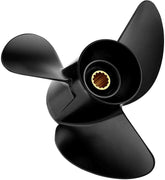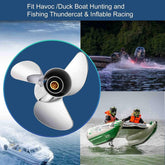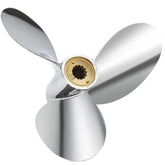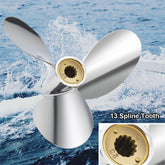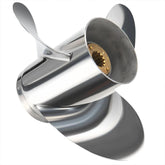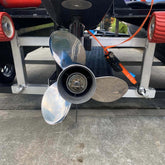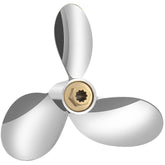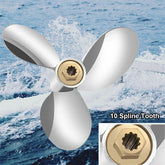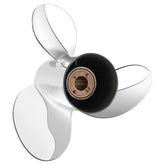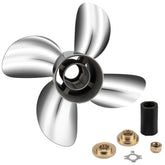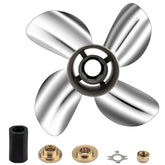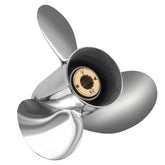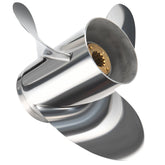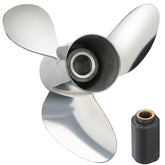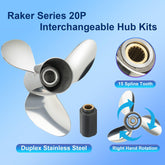Best Boat Propeller Manufacturer: How to Choose, Test and Buy Replacement Props That Actually Work
I’ve worked on docks, at repair shops and at tournament ramps for years. I don’t sell theory — I fix boats and I sell the parts that actually get owners back on the water. This guide tells you what matters when selecting a propeller, how to test it properly, how to diagnose common failures like spun hubs and bent blades, and exactly where to buy tested, compatible props so you minimize returns and downtime.
If you want to browse products, start at the VIF online store and engine collections for quick filtering and compatibility checks. For factory details and production insight visit the company overview and manufacturing deep-dive.
Start shopping and checking compatibility here
Boat Propeller Online store https://vifprop.com/
Boat propeller manufacturer https://vifmarine.com/
How Boat Propellers Are Manufactured https://vifmarine.com/how-boat-propellers-are-manufactured/
Who this guide is for
This is written for boat owners in North America who want practical, field-tested answers:
-
anglers and tournament skippers tuning hole-shot and top speed
-
pontoon and family-boat owners looking for dependable handling with passengers
-
fleet managers who need rapid, durable replacements
-
DIYers who will remove, inspect, and possibly repair or replace a prop themselves
If you want to jump straight to tested SKU collections, check engine-specific pages: propeller for Yamaha https://vifprop.com/collections/propeller-for-yamaha propeller for MERCURY https://vifprop.com/collections/propeller-for-yamaha propeller for Suzuki https://vifprop.com/collections/propeller-for-suzuki propeller for Honda https://vifprop.com/collections/propeller-for-honda propeller for Volvo https://vifprop.com/collections/propeller-for-volvo propeller for tohatsu https://vifprop.com/collections/propeller-for-tohatsu and our popular models in the hot-selling collection https://vifprop.com/collections/hot-selling
The single most important rule: fit first, everything else second
Before swapping blades or arguing about three versus four, make sure the prop will physically fit.
Five facts to confirm from the transom tag or old prop before you buy
-
Engine make, exact model and model year as shown on the transom tag
-
Gearcase code from the transom tag — this determines spline and hub family
-
Spline count and hub type such as Flo-Torq elastomer insert or splined bore
-
Rotation: right-hand, left-hand, or counter-rotation for twin setups
-
Thrust washer and spacer order — reassemble in the original order to avoid hub slip
If the transom tag is unreadable, pull the prop, photograph the hub and splines and upload to the seller for verification. VIF product pages include compatibility matrices to match your gearcase code to SKUs. Using those matrices cuts returns and fit errors dramatically. Start at the online store and the brand collections linked above.
Why pitch, diameter and blade area are the variables that actually matter
You can waste hours on buzzwords. The basics move the needle.
Pitch
Pitch in inches is the primary tuning lever. It controls whether the engine will reach the recommended wide open throttle RPM under your normal load. If your engine cannot reach the manufacturer’s WOT band when the boat is loaded, your pitch is too tall. If the engine over-revs at WOT, your pitch is too small.
Diameter
Affects low-end bite and cavitation margin. Larger diameter moves more water per revolution and helps heavy hulls plane.
Blade area and blade count
More blade area or extra blades increases bite and improves planing under load. Fewer blades reduce drag and favor top speed on light hulls.
Cupping and rake are refinements you apply once pitch and diameter are near correct. Small cupping improves low-RPM bite and helps resist ventilation. Rake alters bow lift and planing angle.
Two formulas to keep on your phone
Theoretical speed in mph equals pitch in inches times RPM divided by 336
Slip percentage equals one minus GPS speed divided by theoretical speed times 100
For planing hulls target roughly 10 to 25 percent slip at WOT with the boat loaded as you normally run it. Use slip together with WOT RPM to decide whether to change pitch or blade area.
The exact on-water test routine I use and teach customers
If you do nothing else, do this test. It converts opinions into data.
Preparation
-
Clean hull growth. Small amounts of barnacle and algae change results.
-
Set trim tabs and trim positions to how you usually run.
-
Load the boat with the people and gear you typically carry. Do not test empty.
-
Warm the engine fully; cold tests lie.
Test passes
-
Run two to three wide-open throttle passes in similar sea conditions and the same direction relative to wind and current.
-
Record GPS speed and tachometer for each pass. Average the readings.
Analysis
-
Compute theoretical speed using pitch and prop RPM.
-
Compute slip.
-
Interpret: WOT RPM below the manufacturer’s band means pitch is too tall. Drop pitch by one inch and retest. WOT RPM above the band means pitch is too short. Increase pitch and retest. If WOT RPM is inside the band but the boat will not plane, increase blade area or try a four-blade.
Change only one variable at a time: pitch first, blade count second, cupping or rake third. Buy baseline plus one alternate pitch or blade count ahead of the test. With reasonable factory-direct pricing you can test two props in a day and choose the clear winner.
If you want to simplify shopping for test props check the hot-selling collection for popular shapes and tournament-tried models https://vifprop.com/collections/hot-selling
Material decision: aluminum or stainless
Aluminum pros and when to use it
-
Low cost, sacrificial behavior in strikes, practical as a trailer spare for shallow launches and rental fleets.
Aluminum cons
-
Thicker blade sections reduce ultimate top-end efficiency and edge retention.
Stainless pros and when to use it
-
Thinner, more hydrodynamic blades, measurable gains in top speed and cruise efficiency, holds shape longer with frequent use.
Stainless cons
-
Higher cost and transmits impact energy to the lower unit more directly. Always carry an aluminum spare if you run shallow.
My practical setup: stainless as daily prop for performance and an aluminum spare on the trailer for peace of mind. VIF lists both materials in engine-specific collections so you can order both in one checkout https://vifprop.com/
Hub systems and spline counts — the real fit traps
Two common hub families cause most fit problems
Flo-Torq elastomer insert hubs
-
Frequently used on Mercury and many modern outboards. They isolate shock and allow replaceable elastomer inserts. If the insert shears a replacement kit will often restore torque transfer without swapping the entire prop.
Solid splined bores
-
Common on Yamaha, Honda, Suzuki and some Volvo units. Exact spline counts matter. A product that only says fits Yamaha without listing spline counts and gearcase codes is not safe to buy.
Buyer tip
-
Look for SKUs with compatibility matrices listing engine model, year, and gearcase code. If unclear, upload photos of your transom tag and hub and ask for verification before purchase.
Relevant product collections for fast matching
-
Propellers for Yamaha https://vifprop.com/collections/propeller-for-yamaha
-
Propellers for MERCURY https://vifprop.com/collections/propeller-for-yamaha
-
Propellers for Suzuki https://vifprop.com/collections/propeller-for-suzuki
-
Propellers for Honda https://vifprop.com/collections/propeller-for-honda
-
Propellers for Volvo https://vifprop.com/collections/propeller-for-volvo
-
Propellers for Tohatsu https://vifprop.com/collections/propeller-for-tohatsu
Ramp diagnosis: spun hub, bent blade or lower-unit damage — how I tell them apart fast
These three cover more than 90% of the problems I see.
Engine revs but boat does not move
-
Likely diagnosis: spun hub or stripped splines.
-
Check: remove the prop and hand-rotate the hub and shaft. If the hub spins on the shaft you have hub failure. Inspect splines for rounding.
-
Fix: replace elastomer insert if serviceable. If splines are damaged tow to shop; do not continue to run the engine.
Heavy vibration at cruise
-
Likely diagnosis: bent blade or imbalance.
-
Check: bench-spin the prop and watch tip runout. Look for cracks near the hub.
-
Fix: small aluminum bends can be straightened and dynamically balanced. Stainless is riskier to repair — replacement is often the long-term choice.
Grinding noises, milky lower-unit oil, metal flakes
-
Likely diagnosis: internal gear or bearing failure.
-
Check: inspect oil for contamination. Smell for burnt scent.
-
Fix: stop the engine and tow to a shop. Running contaminated oil multiplies damage.
Field kit I always carry
-
Spare aluminum prop sized to the engine, a Flo-Torq insert kit, prop nut socket, cotter pins, basic wrenches, a dial indicator, and a phone for photos. That kit solves most weekend problems.
If you need parts quickly visit the VIF online store and the engine collections to find compatible spares fast https://vifprop.com/
Repair versus replace: practical economics
Aluminum
-
Often economical to straighten and dynamically balance. Typical shop charge for straightening and balancing is modest.
Stainless
-
Repairs are more expensive and risk cracking. In many cases replacement is cheaper and more reliable.
Elastomer insert
-
Insert kits are inexpensive and quick to replace on Flo-Torq systems.
Lower unit
-
If oil shows metal flakes or water, plan on towing and a shop estimate. Lower unit gear or bearing work ranges widely in cost and is the most expensive repair category.
Ballpark numbers to expect
-
Elastomer insert kit fifteen to sixty dollars
-
Aluminum straightening and balance thirty to eighty dollars
-
Stainless replacement prop two hundred to seven hundred dollars depending on model
-
Lower unit rebuild five hundred to three thousand five hundred dollars or more depending on parts and labor
Buying flow that reduces returns — exact steps I recommend
-
Photograph your transom tag and the old prop hub. Include any stamped gearcase code and visible splines.
-
Use the VIF product compatibility matrices on the item page to match SKU to engine and gearcase. The compatibility matrix is the single best filter to avoid errors.
-
If in doubt upload your photos via live chat and ask for confirmation. Don’t guess.
-
Order the OEM baseline plus one alternate prop (one inch lower pitch or a different blade count), and include an aluminum spare if you run shallow.
-
Choose U.S. warehouse shipping if you need fast delivery.
-
Run the on-water test flow. Keep packaging until you’re satisfied in case of returns.
Quick shop links again for convenience
Boat Propeller Online store https://vifprop.com/
Hot-selling collection https://vifprop.com/collections/hot-selling
Starter recommendations by horsepower — technician-tested
These are starting points I give fellow owners. Always verify SKU lists your specific gearcase code.
Kicker and small outboards 5–15 hp
-
Start with 7.5×7 to 8×8 three-blade aluminum.
Small runabouts 20–40 hp
-
Start with 9×9 to 10×10 three-blade aluminum.
Midrange 50–90 hp
-
Baseline 11.5 inch diameter by roughly 15 inch pitch stainless; bring an aluminum spare and a four-blade to test.
115–150 hp
-
Baseline 14 by 19 stainless for speed; test a four-blade for heavy-load planing.
175–300+ hp
-
Test 15–17 inch diameter props with 19–25 inch pitch; evaluate cleavers and high-rake variants for high-RPM stability.
Installation tips that avoid surprises
-
Reassemble thrust washers and spacers in original order. Photograph before removal if necessary. Wrong order creates hub slip.
-
Torque the prop nut to spec and secure the cotter pin properly. Loose nuts cause vibration or prop loss.
-
Run a short, low-speed test first before WOT after installing a new prop to check for unexpected vibration.
-
Keep original packaging and part numbers until you’re satisfied in case a return is needed.
Real-world examples
Example A bass boat tune
-
Problem: boat would not plane with two anglers and full live wells. WOT RPM was in the band but plane time slow.
-
Diagnosis: blade area was too small for loaded condition.
-
Fix: swapped to stainless four-blade; plane time improved and slip moved into target range. Owner kept four-blade for tournaments and an aluminum spare on the trailer.
Example B family pontoon vibration
-
Problem: rough vibration at cruise causing passenger complaints.
-
Diagnosis: previous owner installed a slightly bent aluminum spare.
-
Fix: installed dynamically-balanced stainless prop designed for loaded pontoons; vibration resolved and fuel economy improved.
These outcomes are repeatable when fit and balance are prioritized.
Why manufacturing and balancing matter
Two props with the same pitch and diameter can behave differently if casting tolerances are loose or dynamic balance is poor. Bad balance increases bearing loads and causes what owners describe as “driveline noise” that can mask other faults. CNC finishing and dynamic balancing reduce variability and make tuning predictable.
For an inside view of factory processes and quality control read How Boat Propellers Are Manufactured and the company overview at the boat propeller manufacturer page https://vifmarine.com/how-boat-propellers-are-manufactured/ https://vifmarine.com/
FAQ from forums, ramps and customer support
What is the rule of thumb for pitch change effect on RPM
-
About 150–200 RPM per inch in many cases. Use as a starting point not an absolute.
Can I use a Yamaha prop on a Mercury lower unit
-
Only if spline count hub profile and rotation match exactly. Don’t assume cross-brand fit.
How do I compute slip quickly on the water
-
Theoretical speed equals pitch times RPM divided by 336. Slip equals one minus GPS speed divided by theoretical speed times one hundred.
If oil is milky after a strike can I run home
-
No. Milky oil suggests water intrusion. Do not run the engine. Tow to a shop.
Which material should I buy stainless or aluminum
-
Stainless for daily performance and durability. Aluminum as a trailer spare to protect the lower unit in shallow launches.
Where can I buy tested replacements and get help verifying fit
-
Start at the VIF Boat Propeller Online store and the engine-specific collections. Upload photos for verification if unsure https://vifprop.com/ https://vifprop.com/collections/propeller-for-yamaha https://vifprop.com/collections/propeller-for-yamaha https://vifprop.com/collections/propeller-for-suzuki https://vifprop.com/collections/propeller-for-honda https://vifprop.com/collections/propeller-for-volvo https://vifprop.com/collections/propeller-for-tohatsu
Useful external references for deeper reading
Mercury Marine official pages for prop selection and specs give OEM baselines and WOT RPM bands
Yamaha Marine official pages for engine manuals and prop charts
Final checklist before you leave the ramp
-
Photograph transom tag and old prop hub including splines and gearcase code.
-
Match SKU via the product compatibility matrix on the item page. If unclear upload photos for live chat verification.
-
Order the OEM baseline plus one alternate pitch or blade count and an aluminum spare for shallow launches. Shop the Boat Propeller Online store for fast filtering.
-
Run 2–3 WOT passes with your regular load, compute slip and WOT RPM, and iterate.
-
Keep packaging until you are satisfied in case you need to return.
-
Carry a spare aluminum prop and a Flo-Torq insert kit on the trailer.
If you want direct recommendations paste your transom tag info and a clear photo of your old hub here and I’ll recommend two exact SKUs to test — one baseline and one alternate. That’s what I do for owners at the ramp and it usually saves them time and money.


